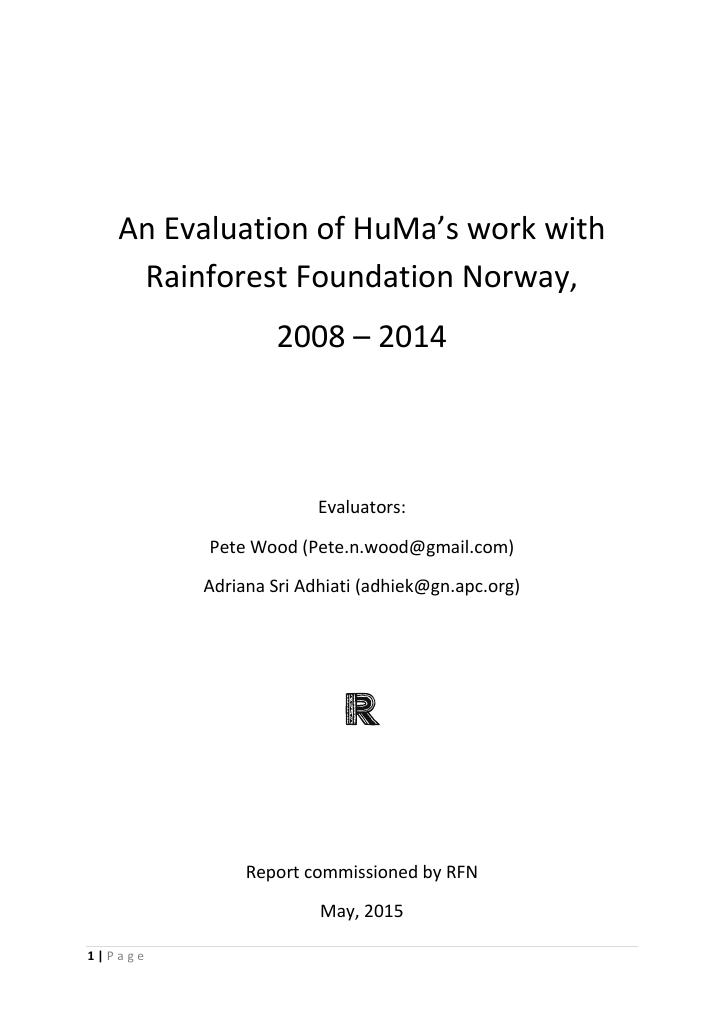Evaluering
Evaluation of Perkumpulan HuMa’s forestry advocacy projects from 2008 to 2014
Background HuMa, the Perkumpulan untuk Pembaharuan Hukum Berbasis Masyarakat dan Ekologis, or Association for Law Reform Based on Community and Ecology, was formed in 2001 to provide legal expertise to the growing forest and community rights policy reform movement in Indonesia, and to help to develop critical legal awareness amongst communities. external evaluation is focused on HuMa’s projects entitled Forestry policy and Advocacy for Legal reform in Indonesia and Community Initiative on Forest conflict Resolution implemented, with a focus on the implementation period between st January 2008 and 31st December 2014. Purpose/objective To assess the relevance, effectiveness, efficiency, impact and sustainability of the RFN-supported project. To provide an overview of the strengths, weaknesses, challenges and gaps in project implementation, and recommendations for how weaknesses can be addressed. To provide an overview of the strengths and weaknesses of organisational structure and internal management, and recommendations for how challenges can be addressed. Methodology Data was collected using a combination of tools including documentary review, interviews with different stakeholders in Jakarta and the rest of Indonesia, and field visits to Padang and Palu undertaken from January, 19th to February, 3rd 2015 Key findings In RFN supported work on forest policy reform and forest conflict resolution, HuMa has been involved in about 75% of important national level events and processes in the forestry sector over the period of the evaluation. Relating to funding, RFN has provided about 12.6 billion IDR/7.7 million NOK/almost 1 million US$ to HuMa over the seven years 2008 – 2014. Overall about 67% has been for Forest Policy and Conflict Resolution, a further 21% for Institutional Development. The HuMa-coordinated CSO coalition to reform the main Forestry Law (KPKK) has not succeeded in its main objective but has contributed to other significant advances. The failure is mainly due to complex external factors, but poor communication and coordination within the CSO network may have contributed. HuMa (with other CSOs) has been successful in raising the profile of forest sector and agrarian conflict, initially within the DKN and then more widely, and in getting rights and tenure recognised as underlying factors in these conflicts. This has contributed to a series of actions by Government to resolve the underlying problems. The HuMaWin conflict database is recognised as a credible source by agencies such as DKN, but there are problems with presentation of data and there are opportunities to promote its use more widely. HuMa’s tradition of strategic review, analysis and planning is one of the strengths of the organisation. The five year organisational strategy will be reviewed in June 2015. A great deal of strategic thinking has happened but HuMa does not have a written strategy which can guide management and board in setting priorities and making decisions. The matrix of results and activities is not a strategy. Recommendations The board and executive should consider ways to reduce the dependence of programs on single donors by looking at the way proposals and programs are structured, and through changes in the ways funds are allocated between programs, while maintaining a transparent and accountable financial system. The board and executive should consider hiring dedicated fundraising staff HuMa should continue to work with the CSO coalition on the reform of the Forestry Law 41/1999, but seek additional alliances with other stakeholders. HuMa board and executive should assess the strategic value of continued engagement with REDD+ and climate change issues and ensure that the work is aligned with HuMa’s vision and mission, and that climate change work contributes to the development of the PHR network and policy reform. HuMa board and members should confirm in the strategy HuMa’s position as a supporter of community rights, not a neutral conflict mediator, and also clarify what is meant by a conflict resolution model/mechanism. The board and executive need to decide how to deal with conflict and land issues outside the forest estate, as these cases will not be affected by the recent advances in forestry policy. To date they have been handled on a case-by-case basis. The executive with a mandate from the board should produce a strategic plan document for 2016 – 2020 from the planning session in 2015. The document should be short and accessible to partners and donors, explains the vision, mission, values, approaches, HuMa’s role and relationships with other key stakeholders. The executive with a mandate from the board should produce a strategy for fund-raising (or include one as part of the organisational strategy). The executive, with the mandate of the board, should plan to diversify funding for core internal costs of strategy development, monitoring and management. Improve communication with donor desk officers, including finding opportunities for efficiency in communicating to members and donors simultaneously. Ensure that donors are informed of significant workplan and financial changes, and that where necessary these changes are discussed with donors in advance.
